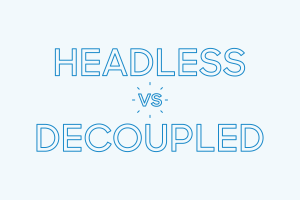Headless vs. Decoupled: What’s the Difference?

Collection :
These days, the search for the right content management system (CMS) can feel like navigating a labyrinth of jargon and tech specs. Depending on your organization’s needs, the list of possibilities can be dizzying. Should your CMS be open source? Is it API-first? Does it support responsive design? What about third-party integrations?
Then there’s the underlying architecture. You may have come across terms like “headless” and “decoupled” in reference to CMS architecture. The terms are often used interchangeably, but they’re not exactly the same thing. While a headless CMS does have a decoupled architecture, not all decoupled systems are headless. In this post, we’ll explore what both terms mean and how one differs from the other.
While a headless CMS does have a decoupled architecture, not all decoupled systems are headless.
It helps to take a step back. If you’re digging this deep, you probably already know the basics of what a content management system is: a software platform used to create, store, and manage content types and to publish that content to a website and other digital channels. Historically, CMSs have been typically used to publish blog posts and static pages on websites, but the modern CMS is built to do much more. Today, they’re the heart of an omnichannel digital experience that integrates with other systems and dynamically pushes content to a range of devices. But exactly how well a CMS supports this kind of digital experience depends on its architecture, which is why understanding concepts like unified, hybrid, headless, and decoupled architectures is so important.
What is a decoupled architecture?
Traditionally, content management systems have come in what is known as a unified architecture, meaning that the back end (where the content is created and stored) is tightly intertwined with the front end, sometimes known as the “head” (where the design and presentation layer live).
In a decoupled architecture, by contrast, the front and back ends of the CMS are detached and housed independently from one another, effectively disconnecting the processes of creating and delivering the content. The CMS delivers content from the back end to the front end via an API, which can also be used to push content elsewhere. So while the head is detached, it’s still there as an option.
A decoupled architecture typically refers to some type of application that provides the front-end experience, along with one or more API services to provide the content and data. So, we would typically include the user interface in the decoupled architecture, whether that’s a JavaScript application, mobile app, smart TV, digital signage, or something else.
So what is a headless CMS?
A headless CMS is a back end-only content management system with a decoupled architecture that publishes content to a variety of channels via API endpoints. A headless CMS uses APIs to deploy content, but it lacks a front-end presentation layer entirely, leaving the front-end architecture and delivery up to developers. Drupal is a powerful and popular choice for a headless CMS because it is API-first, not API-only. That trait means that it was specifically designed with an API services layer at its core.
A headless CMS is ideal for omnichannel digital publishing, allowing content creators to push content out to a wide range of channels from websites and mobile devices to connected IoT gadgets, smartwatches, and digital billboards. Headless CMS solutions are also more ideal for organizations with larger development resources on hand because of the amount of custom coding and development they require.
What’s the main difference between headless and decoupled?
Technically, a headless CMS has a decoupled architecture, which is why the terms can be confused. But while headless CMSs are decoupled, not all CMSs with a decoupled architecture are headless. Often, a decoupled system has an optional front end, while a headless CMS has none at all. In other words, a headless CMS is truly front-end agnostic.
The distinctions between headless and decoupled can be pretty nuanced and hard to parse. Here’s a good rule of thumb: “Headless” usually refers to the CMS or the service providing data via the API, and “decoupled” typically refers to the architecture or the front-end application itself.
Pros and cons of a headless CMS
The perks and disadvantages of adopting a decoupled architecture or headless CMS can vary in magnitude depending on an organization’s needs and resources.
Some advantages of headless and decoupled systems include:
- Omnichannel content capabilities. By freeing the back-end content repository from the confines of a specific front end, the headless architecture allows content to be distributed dynamically to a variety of devices so it can reach consumers wherever they are.
- Greater flexibility, performance, and agility. The open-ended front-end architecture lets developers build presentation layers — and continually iterate on them — for a variety of devices using whatever coding frameworks and technologies they prefer. This front-end flexibility also allows developers to innovate more easily.
- Readiness for the future. APIs let developers integrate with newer technologies and front-end systems, establishing a future-ready content management system.
But these systems have their drawbacks and limitations too. A few cons to consider:
- Resource intensiveness. More customized or complex implementations require more front-end coding work, which can be prohibitive for organizations with small development teams.
- Limited content preview options. Since the front-end presentation layer is decoupled from the back end, it may not be as easy to generate a live preview of content across channels.
- An adjustment for some users. Marketers may find them more challenging to use than the more traditional CMSs they’re accustomed to.
Getting started with a headless CMS
For the greatest flexibility and agility, a headless CMS is typically the way to go, but it really depends on an organization’s needs and resources. If there’s a need for truly omnichannel digital content distribution – and these days, there almost always is – an API-first, headless CMS architecture makes for a powerful back-end repository that can support an omnichannel customer journey.
Curious to see a headless CMS in action? Sign up to access the beta version of the Acquia CMS Headless Starter Kit for a sneak peek at what’s possible with this technology.


